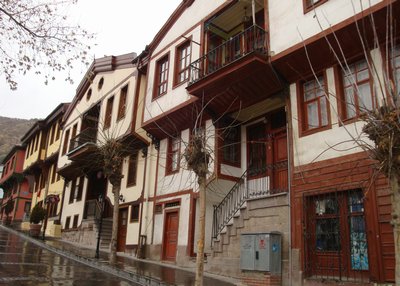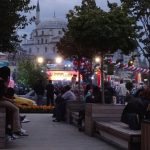Last night I had the weirdest sensation. I was walking back from the İkbal Lokantası in Afyon town centre to the Şehitoğlu Konaği in the old part of town when for a fleeting second I actually felt as if I were back in Ottoman times, hurrying home in the dark, stopping to pick up a few odds and bods of groceries along the way. It was the half-light that did it, I think. That and the fact that it was dinner time and few cars were about. Mainly, though, it was because so many Ottoman houses have managed to survive in this part of town, the ground floors of some of them still occupied by little one-man grocery stores so that it feels like a piece of living history.
Afyon was always a much under-rated town. It wasn’t just the view from the “karahisar (black castle)” that gave it its full name (Afyonkarahisar) that originally won me over but the fact that so much of the Ottoman townscape still survived around the Ulu Cami at the bottom of the path leading up to the castle. When I first visited the houses were mainly pretty dilapidated, lived in, as so often, by the town’s poorer residents. Now, though, when all things Ottoman are back in fashion, those same houses have become the jewels in Afyon’s touristic crown. When the Şehitoğlu Konağı opened in two of those houses a couple of years ago it finally gave Afyon what it had been desperately missing: a boutique hotel of which it could be proud.
So first to that hotel. Let’s start by staying simply that I loved it. So there was a school across the road that guaranteed an earlier wake-up call than I really wanted. So there was an irritating pinging noise coming from some gadget (the fire detector?) in the corridor. So the owner was pretty insistent that I return early to the hotel so that the staff needn’t linger. Petty quibbles when compared to the sheer joy of a room that in every way matched my idea of what a modernised Ottoman bedroom should look like. The phrase that sprang to mind to describe it was shabby chic except that I’m afraid that is a very British concept that may sound pejorative when it’s intended to be anything but. Because, with its honey-brown and gold colour scheme, hand-painted picture of Afyon in the niche above the bed and neatly tiled bathroom tucked away in the cupboard this was renovation as it surely should be and rarely is. The “shabby” part was suggested only by the partially exposed, unpainted floorboards and by the mildly distressed appearance of original cupboard doors that had been revarnished, all so much more attractive than the over airbrushed versions of Ottoman that are sometimes dished up to travellers.
Then to the İkbal, a venerable survivor that was just as I remembered it from previous visits – the same framed carpets, the same huge mirrors with gilded frames, the same cauldrons of hot food, the same desserts artfully lined up behind glass. Unfortunately I got the feeling that it was resting on its laurels, that the action might now be focused on the much bigger, brasher branch out near the new otogar and the İkbal-owned shopping mall. True, the tandır kebap was still tasty and the vişneli ekmek kadayıf with thick, glorious Afyon cream a delight, but the bill came to TL29. Surprising, then, that my request for a çay to round off the mean was met with a not especially apologetic no.
All that was by the by though because what really struck me on this visit was the date engraved on the window. 1922. The İkbal, in other words, opened at the end of Turkey’s three-year War of Independence, and what a wonder it must have seemed then, bringing good food and enjoyment to a part of the country that had suffered dreadfully during the war. For just fifty kilometres west of Afyon is Dumlupınar where, on 30 August 1922, the Turkish army finally routed the Greeks who had invaded the country in the aftermath of the First World War. A little over two weeks later and the last Greeks had been forced out of Anatolia.
For an outsider it’s sometimes hard to remember the significance of all this for Turks. It also takes time to start to notice the evidence of the trauma even when it’s staring us in the face, as it is, for example, in the shattered minarets of Bilecik and the bullet holes in the tomb of Ertuğrul Gazi at Soğüt.
The İkbal, then, must have seemed a beacon, a promise of better to come, and for that, I’ll forgive it an off night.


